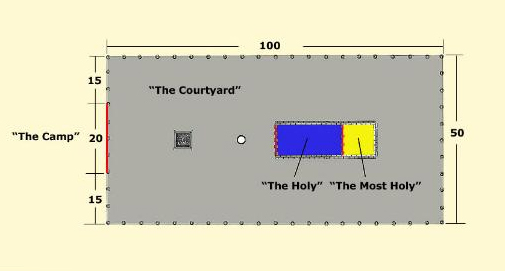
The directions given to Moses for the construction of the Tabernacle may be found in Exod. 25 to 27, and the account of the performance of the work, in Exod. 35 to 40. The picture above on the left is one of the many typical representations of the Tabernacle found on the internet, one which we might add incorporates numerous errors which we will address later in this study; the second illustration on the right is a more accurate rendering.
Briefly stated, the Tabernacle was a house constructed of a series of boards of shittim (acacia) wood, "overlaid" or plated with gold, set on end into sockets of silver, and firmly fastened together by bars of the same wood, also covered with gold.

This structure was 15 feet wide, 15 feet high and 45 feet long, and open at the front or east end. It was covered by a large white linen cloth, interwoven with figures of cherubim, in blue, purple and scarlet. The open end, or front of the structure, was closed by a curtain of similar material to the covering cloth, called the "Door," or first veil. Another cloth of the same material, similarly woven with figures of cherubim, called the "Veil" (or second veil), was hung so that it divided the Tabernacle into two apartments. The first or larger apartment, 15 feet wide and 30 feet long, was called the "Holy."* The second or rear apartment, 15 feet wide and 15 feet long, was called the "Most Holy." These two apartments constituted the Tabernacle proper; and a tent was erected over them for shelter. It was made of a covering of cashmere cloth or goat hair, another of ram skins dyed red, and another of seal skins (mistranslated badger skins), as depicted in the second illustration to the right at the top of the page. We will examine these various coverings in more detail later.
The Holy Court or Holy Place

This is a picture of the Tabernacle courtyard which I found on the internet one of the few which accurately depicts the courtyard as it should be, I have intentionally removed the tabernacle itself and its appointments so that we might concentrate on the courtyard curtain itself. Note the measurements here given are in *cubits.
The Tabernacle was surrounded by a yard, or "Court," toward the rear of which it stood. This court, 75 feet wide and 150 feet long, was formed by a fence of linen curtains, suspended from silver hooks, set in the tops of wooden posts 7 1/2 feet high, which were set in heavy sockets of copper (mistranslated brass), and braced, like the tent which covered the Tabernacle, with cords and pins. This enclosure was all holy ground, and was therefore called the "Holy Place"--also the "Court of the Tabernacle." Its opening, like the door of the Tabernacle, was towards the east, and was called the "Gate." This "Gate" was of white linen, interwoven with blue, purple and scarlet. It will be noticed that the three entrance passages, viz., the "Gate" into the "Court," the "Door" into the "Holy" and the "Veil" into the "Most Holy," were of the same material and colors.

Outside the Tabernacle and its "Court" was the "Camp" of Israel surrounding it on all sides at a respectful distance.
...................................................................................................................
*In the English translation this is frequently, though improperly, called the "holy place," and in such instances the word place will be found in italics, indicating that it has been supplied by the translators, as, for instance, in Exod. 26:33. This error is quite confusing, as the "Court" was properly called the "holy place." When place is not in italics, the "Court" is always meant. See Lev. 14:13 and 6:26, 27. In some instances the "Holy" is termed the "Tabernacle of the congregation."
The "Most Holy," or "Sanctuary," is also sometimes called the "Holy place"--place in italics. Instances, Lev. 16:17, 20, 23. In referring to these apartments, we will call them, simply, the "Court," "The Holy" and "The Most Holy."
A lack of appreciation of the interest of believers in these typical pictures and of the necessity for uniform exactness, on the part of the translators of Leviticus, must have been the cause of the varied translations which have so aided in confusing the student.
*The “cubit” was a unit of measurement somewhere between 16 and 25 inches, to be determined based upon what specifically one was measuring, whether that be land measurements, distance, (time) or building measurements, i.e. construction.
Excerpts were taken from “Tabernacle Shadows of Better Sacrifices”, T12-14
Now before we delve into the specifics of the Tabernacle and its construction, layout, furnishings and etc. as it depicts the progress of the believers journey God-ward, we would first like to take a look at two of the most important services or ceremonies connected with the Tabernacle, the Consecration of the Priesthood, and the Great Day of Atonement.
Back to Index

